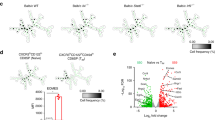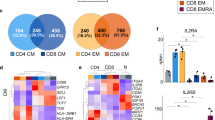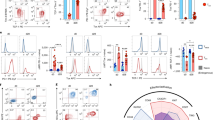Key Points
-
Memory T cells, which are derived from naive T cells and carry the 'memory' of a previous exposure to an antigen, are long lived, have enhanced functional capacity compared with naive T cells and serve as the cellular basis of immunological memory.
-
Memory T cells are heterogeneous populations and can be divided into two main subsets: central memory T cells (which have stem cell-like properties and circulate in lymphoid organs) and effector memory T cells (which circulate in non-lymphoid tissues and perform rapid effector functions following activation).
-
Compared with naive T cells, memory T cells highly express a few hundred genes that have an array of functions and serve as the transcriptional basis for the unique function of memory T cells.
-
The highly expressed genes in memory T cells can be further divided into two main classes based on the pattern of their expression before and after antigen-mediated T cell activation. The first group includes genes that are highly expressed by resting memory T cells but not by resting naive T cells, whereas the second group includes genes that are expressed more highly by activated memory T cells than by activated naive T cells. Genes that are expressed at similar levels in resting naive and memory T cells but are more highly expressed by activated memory T cells than by activated naive T cells are called 'poised' genes.
-
Chromatin states (open or closed) are regulated by chemical modifications of DNA and histones; such modifications are considered to be epigenetic changes. The particular patterns of DNA methylation and histone modification are closely associated with the expression status of memory T cell highly expressed genes and may have a key role in the regulation of the differential gene expression and function of memory T cells.
-
A better understanding of the functions and epigenetic regulation of highly expressed genes in memory T cells will enable us to elucidate how memory T cell formation, maintenance and function, as well as the consequences of dysregulation of epigenetic changes, contribute to the altered function of the immune system in degenerative processes, such as autoimmunity and ageing.
Abstract
How the immune system remembers a previous encounter with a pathogen and responds more efficiently to a subsequent encounter has been one of the central enigmas for immunologists for over a century. The identification of pathogen-specific memory lymphocytes that arise after an infection provided a cellular basis for immunological memory. But the molecular mechanisms of immunological memory remain only partially understood. The emerging evidence suggests that epigenetic changes have a key role in controlling the distinct transcriptional profiles of memory lymphocytes and thus in shaping their function. In this Review, we summarize the recent progress that has been made in assessing the differential gene expression and chromatin modifications in memory CD4+ and CD8+ T cells, and we present our current understanding of the molecular basis of memory T cell function.
This is a preview of subscription content, access via your institution
Access options
Subscribe to this journal
Receive 12 print issues and online access
$209.00 per year
only $17.42 per issue
Buy this article
- Purchase on Springer Link
- Instant access to full article PDF
Prices may be subject to local taxes which are calculated during checkout



Similar content being viewed by others
References
Bevan, M. J. Understand memory, design better vaccines. Nature Immunol. 12, 463–465 (2011).
Pulendran, B. & Ahmed, R. Immunological mechanisms of vaccination. Nature Immunol. 12, 509–517 (2011).
Sallusto, F., Lenig, D., Forster, R., Lipp, M. & Lanzavecchia, A. Two subsets of memory T lymphocytes with distinct homing potentials and effector functions. Nature 401, 708–712 (1999).
Pepper, M. & Jenkins, M. K. Origins of CD4+ effector and central memory T cells. Nature Immunol. 12, 467–471 (2011).
Hyatt, G. et al. Gene expression microarrays: glimpses of the immunological genome. Nature Immunol. 7, 686–691 (2006).
Haining, W. N. & Wherry, E. J. Integrating genomic signatures for immunologic discovery. Immunity 32, 152–161 (2010).
Kaech, S. M., Hemby, S., Kersh, E. & Ahmed, R. Molecular and functional profiling of memory CD8 T cell differentiation. Cell 111, 837–851 (2002). This pioneering study showed the changes in global gene expression that occur as CD8+ naive T cells differentiate into effector and then memory T cells after viral infection and suggested that antigen-specific CD8+ T cells progressively differentiate into memory T cells following viral infection.
Liu, K. et al. Augmentation in expression of activation-induced genes differentiates memory from naive CD4+ T cells and is a molecular mechanism for enhanced cellular response of memory CD4+ T cells. J. Immunol. 166, 7335–7344 (2001).
Holmes, S., He, M., Xu, T. & Lee, P. P. Memory T cells have gene expression patterns intermediate between naive and effector. Proc. Natl Acad. Sci. USA 102, 5519–5523 (2005).
Willinger, T., Freeman, T., Hasegawa, H., McMichael, A. J. & Callan, M. F. Molecular signatures distinguish human central memory from effector memory CD8 T cell subsets. J. Immunol. 175, 5895–5903 (2005).
Luckey, C. J. et al. Memory T and memory B cells share a transcriptional program of self-renewal with long-term hematopoietic stem cells. Proc. Natl Acad. Sci. USA 103, 3304–3309 (2006).
Haining, W. N. et al. Identification of an evolutionarily conserved transcriptional signature of CD8 memory differentiation that is shared by T and B cells. J. Immunol. 181, 1859–1868 (2008).
Araki, Y. et al. Genome-wide analysis of histone methylation reveals chromatin state-based regulation of gene transcription and function of memory CD8+ T cells. Immunity 30, 912–925 (2009). This study identifies four different modes of association between histone methylation and differential gene expression in CD8+ memory T cells, providing a chromatin basis for the differential gene expression and function of memory CD8+ T cells.
Wirth, T. C. et al. Repetitive antigen stimulation induces stepwise transcriptome diversification but preserves a core signature of memory CD8+ T cell differentiation. Immunity 33, 128–140 (2010). This study reveals signature genes of CD8+ memory T cells and their complex regulation following repeated antigenic challenges.
Chevalier, N. et al. CXCR5 expressing human central memory CD4 T cells and their relevance for humoral immune responses. J. Immunol. 186, 5556–5568 (2011).
Novershtern, N. et al. Densely interconnected transcriptional circuits control cell states in human hematopoiesis. Cell 144, 296–309 (2011).
Marshall, H. D. et al. Differential expression of Ly6C and T-bet distinguish effector and memory Th1 CD4+ cell properties during viral infection. Immunity 35, 633–646 (2011).
Rossi, R. L. et al. Distinct microRNA signatures in human lymphocyte subsets and enforcement of the naive state in CD4+ T cells by the microRNA miR-125b. Nature Immunol. 12, 796–803 (2011).
Hertoghs, K. M. et al. Molecular profiling of cytomegalovirus-induced human CD8+ T cell differentiation. J. Clin. Invest. 120, 4077–4090 (2010).
Kato, K. et al. Identification of stem cell transcriptional programs normally expressed in embryonic and neural stem cells in alloreactive CD8+ T cells mediating graft-versus-host disease. Biol. Blood Marrow Transplant. 16, 751–771 (2010).
Turtle, C. J. et al. Innate signals overcome acquired TCR signaling pathway regulation and govern the fate of human CD161hi CD8α+ semi-invariant T cells. Blood 118, 2752–2762 (2011).
Lai, W. et al. Transcriptional control of rapid recall by memory CD4 T cells. J. Immunol. 187, 133–140 (2011).
Bonasio, R., Tu, S. & Reinberg, D. Molecular signals of epigenetic states. Science 330, 612–616 (2010).
Berger, S. L. The complex language of chromatin regulation during transcription. Nature 447, 407–412 (2007).
Berger, S. L., Kouzarides, T., Shiekhattar, R. & Shilatifard, A. An operational definition of epigenetics. Genes Dev. 23, 781–783 (2009).
Guenther, M. G., Levine, S. S., Boyer, L. A., Jaenisch, R. & Young, R. A. A chromatin landmark and transcription initiation at most promoters in human cells. Cell 130, 77–88 (2007).
Barski, A. et al. High-resolution profiling of histone methylations in the human genome. Cell 129, 823–837 (2007).
Zhang, Z. & Pugh, B. F. High-resolution genome-wide mapping of the primary structure of chromatin. Cell 144, 175–186 (2011).
Deaton, A. M. & Bird, A. CpG islands and the regulation of transcription. Genes Dev. 25, 1010–1022 (2011).
Saxonov, S., Berg, P. & Brutlag, D. L. A genome-wide analysis of CpG dinucleotides in the human genome distinguishes two distinct classes of promoters. Proc. Natl Acad. Sci. USA 103, 1412–1417 (2006).
Maunakea, A. K. et al. Conserved role of intragenic DNA methylation in regulating alternative promoters. Nature 466, 253–257 (2010).
Avni, O. et al. TH cell differentiation is accompanied by dynamic changes in histone acetylation of cytokine genes. Nature Immunol. 3, 643–651 (2002).
Chang, S. & Aune, T. M. Dynamic changes in histone-methylation 'marks' across the locus encoding interferon-γ during the differentiation of T helper type 2 cells. Nature Immunol. 8, 723–731 (2007).
Northrup, D. L. & Zhao, K. Application of ChIP-Seq and related techniques to the study of immune function. Immunity 34, 830–842 (2011).
Syrbe, U. et al. Differential regulation of P-selectin ligand expression in naive versus memory CD4+ T cells: evidence for epigenetic regulation of involved glycosyltransferase genes. Blood 104, 3243–3248 (2004).
Schmidl, C. et al. Epigenetic reprogramming of the RORC locus during in vitro expansion is a distinctive feature of human memory but not naive Treg. Eur. J. Immunol. 41, 1491–1498 (2011).
Steinfelder, S. et al. Epigenetic modification of the human CCR6 gene is associated with stable CCR6 expression in T cells. Blood 117, 2839–2846 (2011).
Fitzpatrick, D. R., Shirley, K. M. & Kelso, A. Stable epigenetic inheritance of regional IFN-γ promoter demethylation in CD44highCD8+ T lymphocytes. J. Immunol. 162, 5053–5057 (1999).
Kersh, E. N. et al. Rapid demethylation of the IFN-γ gene occurs in memory but not naive CD8 T cells. J. Immunol. 176, 4083–4093 (2006).
Northrop, J. K., Thomas, R. M., Wells, A. D. & Shen, H. Epigenetic remodeling of the IL-2 and IFN-γ loci in memory CD8 T cells is influenced by CD4 T cells. J. Immunol. 177, 1062–1069 (2006).
Yamashita, M. et al. Bmi1 regulates memory CD4 T cell survival via repression of the Noxa gene. J. Exp. Med. 205, 1109–1120 (2008).
Youngblood, B. et al. Chronic virus infection enforces demethylation of the locus that encodes PD-1 in antigen-specific CD8+ T cells. Immunity 35, 400–412 (2011).
Deaton, A. M. et al. Cell type-specific DNA methylation at intragenic CpG islands in the immune system. Genome Res. 21, 1074–1086 (2011).
Fields, P. E., Kim, S. T. & Flavell, R. A. Changes in histone acetylation at the IL-4 and IFN-γ loci accompany Th1/Th2 differentiation. J. Immunol. 169, 647–650 (2002).
Messi, M. et al. Memory and flexibility of cytokine gene expression as separable properties of human TH1 and TH2 lymphocytes. Nature Immunol. 4, 78–86 (2003).
Yamashita, M. et al. Interleukin (IL)-4-independent maintenance of histone modification of the IL-4 gene loci in memory Th2 cells. J. Biol. Chem. 279, 39454–39464 (2004).
Fann, M. et al. Histone acetylation is associated with differential gene expression in the rapid and robust memory CD8+ T cell response. Blood 108, 3363–3370 (2006).
Araki, Y., Fann, M., Wersto, R. & Weng, N. P. Histone acetylation facilitates rapid and robust memory CD8 T cell response through differential expression of effector molecules (eomesodermin and its targets: perforin and granzyme B). J. Immunol. 180, 8102–8108 (2008).
Northrop, J. K., Wells, A. D. & Shen, H. Chromatin remodeling as a molecular basis for the enhanced functionality of memory CD8 T cells. J. Immunol. 181, 865–868 (2008).
Wei, G. et al. Global mapping of H3K4me3 and H3K27me3 reveals specificity and plasticity in lineage fate determination of differentiating CD4+ T cells. Immunity 30, 155–167 (2009). This study identifies the chromatin states of key transcription factor genes and their target genes in naive CD4+ T cells differentiating into distinct lineages (including T H 1, T H 2, T H 17 and inducible regulatory T cells) and suggests that an epigenetic mechanism underlies the specificity and plasticity of effector and regulatory T cells.
Nakata, Y. et al. c-Myb, Menin, GATA-3, and MLL form a dynamic transcription complex that plays a pivotal role in human T helper type 2 cell development. Blood 116, 1280–1290 (2010).
Yamashita, M. et al. Crucial role of MLL for the maintenance of memory T helper type 2 cell responses. Immunity 24, 611–622 (2006). This study demonstrates that MLL regulates histone modifications and expression at the GATA3 locus, indicating that MLL has a crucial role in the maintenance of memory T H 2 cells.
Zediak, V. P., Johnnidis, J. B., Wherry, E. J. & Berger, S. L. Persistently open chromatin at effector gene loci in resting memory CD8+ T cells independent of transcriptional status. J. Immunol. 186, 2705–2709 (2011).
Cannarile, M. A. et al. Transcriptional regulator Id2 mediates CD8+ T cell immunity. Nature Immunol. 7, 1317–1325 (2006).
Bernstein, B. E. et al. A bivalent chromatin structure marks key developmental genes in embryonic stem cells. Cell 125, 315–326 (2006).
Cui, K. et al. Chromatin signatures in multipotent human hematopoietic stem cells indicate the fate of bivalent genes during differentiation. Cell Stem Cell 4, 80–93 (2009).
Seit-Nebi, A., Cheng, W., Xu, H. & Han, J. MLK4 has negative effect on TLR4 signaling. Cell. Mol. Immunol. 9, 27–33 (2012).
Murphy, K. M. & Stockinger, B. Effector T cell plasticity: flexibility in the face of changing circumstances. Nature Immunol. 11, 674–680 (2010).
Lu, K. T. et al. Functional and epigenetic studies reveal multistep differentiation and plasticity of in vitro-generated and in vivo-derived follicular T helper cells. Immunity 35, 622–632 (2011).
Wang, Z. et al. Combinatorial patterns of histone acetylations and methylations in the human genome. Nature Genet. 40, 897–903 (2008).
Thomson, J. P. et al. CpG islands influence chromatin structure via the CpG-binding protein Cfp1. Nature 464, 1082–1086 (2010).
Wang, Z. et al. Genome-wide mapping of HATs and HDACs reveals distinct functions in active and inactive genes. Cell 138, 1019–1031 (2009).
van der Vlag, J. & Otte, A. P. Transcriptional repression mediated by the human polycomb-group protein EED involves histone deacetylation. Nature Genet. 23, 474–478 (1999).
Zediak, V. P., Wherry, E. J. & Berger, S. L. The contribution of epigenetic memory to immunologic memory. Curr. Opin. Genet. Dev. 21, 154–159 (2011).
Nakaya, H. I. et al. Systems biology of vaccination for seasonal influenza in humans. Nature Immunol. 12, 786–795 (2011).
Lu, Q. et al. Demethylation of CD40LG on the inactive X in T cells from women with lupus. J. Immunol. 179, 6352–6358 (2007).
Hu, N. et al. Abnormal histone modification patterns in lupus CD4+ T cells. J. Rheumatol. 35, 804–810 (2008).
Acknowledgements
We thank R. Hodes, K. Zhao and the anonymous reviewers for critical reading of the manuscript and helpful suggestions. This research was supported by the Intramural Research Programs of the US National Institute on Aging, National Institutes of Health.
Author information
Authors and Affiliations
Corresponding author
Ethics declarations
Competing interests
The authors declare no competing financial interests.
Related links
Glossary
- Epigenetic regulation
-
The modifications on DNA, histones and other targets that collectively determine a stable phenotype without altering the DNA sequence. Epigenetic changes can pass from the parental cells to their offspring and provide a molecular basis for cellular memory.
- Chromatin
-
The combination of DNA, histones and other proteins that comprises eukaryotic chromosomes. The basic repeating unit of chromatin is the nucleosome, which consists of an octamer of histone proteins around which ∼ 146 base pairs of DNA is wound.
- Central memory T cells
-
(TCM cells). Antigen-experienced T cells that lack immediate effector function but can mediate rapid recall responses. They also rapidly develop the phenotype and function of effector memory T cells after re-stimulation with antigen. TCM cells retain the migratory properties of naive T cells and therefore circulate through the secondary lymphoid organs.
- Effector memory T cells
-
(TEM cells). Terminally differentiated T cells that lack lymph node-homing receptors but express receptors that enable them to home to inflamed tissues. TEM cells can exert immediate effector functions without the need for further differentiation.
- Microarray
-
A tool for measuring gene transcription. Its use involves the hybridization of fluorescently labelled cDNA prepared from a cell or tissue of interest with thousands of known oligonucleotides or cDNAs dotted on glass slides or other surfaces. The known DNA ideally represents all of the expressed genes in the species.
- Heterochromatin
-
High-density regions in the nucleus that are thought to contain compacted chromatin structures associated with silent genes.
- Chromatin immunoprecipitation
-
A technique that uses antibodies specific for transcription factors or other DNA-binding proteins to precipitate associated DNA sequences from chromatin to study their functional relationship.
- Reverse transcription PCR
-
A type of PCR in which RNA is converted into complementary DNA (cDNA), which is then amplified.
- ChIP–seq
-
A technique in which chromatin immunoprecipitation (ChIP) is followed by high-throughput sequencing to generate a genome-wide distribution map of protein–DNA interactions. This technique can be used to measure transcription factor binding and histone modifications.
- Toll-like receptor
-
(TLR). A member of a family of receptors that are homologous to Drosophila melanogaster Toll. TLRs recognize conserved molecular patterns that are unique to microorganisms. The lipopolysaccharide component of bacterial cell walls is one such ligand. TLRs can also recognize mammalian components and contribute to autoimmunity.
Rights and permissions
About this article
Cite this article
Weng, Np., Araki, Y. & Subedi, K. The molecular basis of the memory T cell response: differential gene expression and its epigenetic regulation. Nat Rev Immunol 12, 306–315 (2012). https://doi.org/10.1038/nri3173
Published:
Issue Date:
DOI: https://doi.org/10.1038/nri3173
This article is cited by
-
Per-cell histone acetylation is associated with terminal differentiation in human T cells
Clinical Epigenetics (2024)
-
Epigenetic reprogramming of T cells: unlocking new avenues for cancer immunotherapy
Cancer and Metastasis Reviews (2024)
-
Modulation of Mesenchymal Stem Cells-Mediated Adaptive Immune Effectors’ Repertoire in the Recovery of Systemic Lupus Erythematosus
Stem Cell Reviews and Reports (2023)
-
Early-to-mid stage idiopathic Parkinson’s disease shows enhanced cytotoxicity and differentiation in CD8 T-cells in females
Nature Communications (2023)
-
The applications of DNA methylation as a biomarker in kidney transplantation: a systematic review
Clinical Epigenetics (2022)



